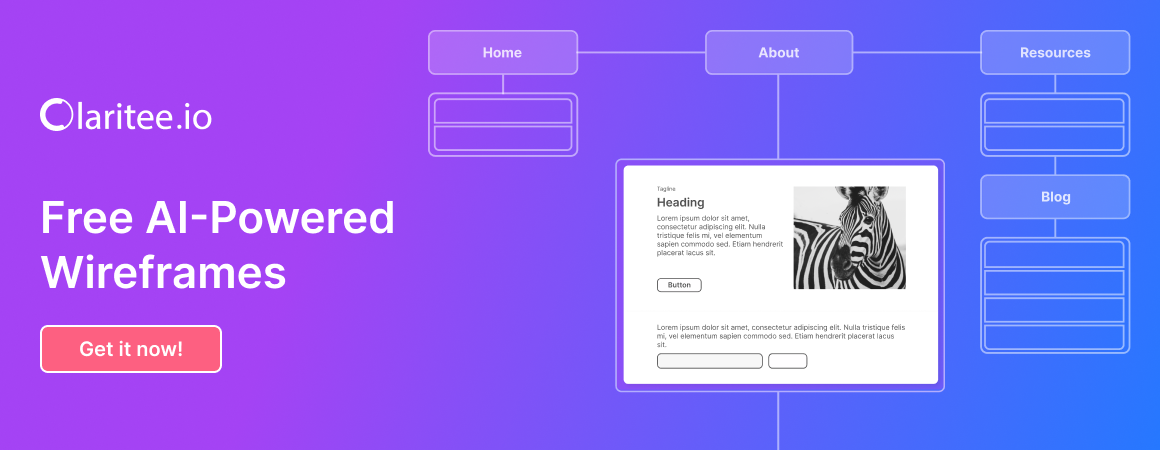In any UX/UI or product development process, clarity is everything.
Clear, actionable design requirements are what turn an idea into a product that actually matches its vision.
Design requirements ensure everyone — designers, developers, and stakeholders — understands exactly what’s being built and why.
Done right, they save weeks of back-and-forth and prevent costly miscommunication.
Claritee makes this process visual. Instead of managing long requirement documents, you can plan and align your entire structure, content, and wireframes in one shared workspace.
What Are Design Requirements?
Design requirements define the criteria a design must meet to be successful.
They act as a blueprint for execution and alignment.
They usually cover:
- Functionality – what the product must do
- User Experience – how users should interact with it
- Aesthetics – the look and feel
- Technical Constraints – platforms, devices, or performance limits
They’re drawn from stakeholders, user research, and business goals, and form the foundation for every design and development decision.
Step-by-Step: How to Write Effective Design Requirements
1. Understand the Project Goals
Start with the why. Every requirement should link back to a clear business or user goal.
Ask:
- What problem is this solving?
- Who are the target users?
- What is the measurable outcome?
Keeping these visible throughout the design phase ensures alignment.
Claritee lets you create a master note for the entire project – so strategy never gets buried.
2. Define the Scope
Define exactly what the project covers — and what it doesn’t.
This keeps expectations realistic and protects the timeline.
Example:
Include homepage, product page, and checkout flow.
Exclude email templates and admin dashboard.
Claritee’s sitemap view makes this crystal clear, showing scope boundaries visually so everyone stays on track.
3. Identify User Needs and Personas
Good design starts with understanding real users.
Develop personas that include:
- Goals and motivations
- Pain points
- Behavioral patterns
Example Requirement:
“The homepage should guide new users toward the product catalog within one click.”
You can link personas and research notes directly to relevant pages in Claritee, creating a direct line between insight and implementation.
4. Prioritize Features and Functionality
Not every feature matters equally.
Group them into:
- Must-Haves – core functionality
- Nice-to-Haves – enhancements that add polish
Example:
Must-Have: Mobile responsiveness
Nice-to-Have: Color theme customization
Claritee helps you visualize these priorities page by page — ideal for client approvals or sprint planning.
5. Write Specific, Actionable Requirements
Vague instructions create chaos. Requirements must be precise and measurable.
Clear:
“Include a persistent top navigation bar with Home, About, Services, and Contact.”
Unclear:
“Add a user-friendly menu.”
In Claritee, these requirements can be attached via a comment to each section or element, so there’s no guesswork during design or development.
6. Address Technical Constraints
Every design lives inside certain limits — performance, frameworks, devices, and integrations.
Example:
“Optimize all images for a sub-3-second load time on mobile.”
Claritee integrates directly with Webflow and WordPress, making it easy to test feasibility early and avoid technical surprises later.
7. Include Aesthetic and Branding Guidelines
Ensure consistency across the entire product:
- Colors and typography
- Visual hierarchy
- Layout rhythm
Example:
“Use the primary blue (#0047FF) and white (#FFFFFF) for all call-to-action sections.”
Claritee’s Design System mode lets you define these globally.
8. Include Accessibility Requirements
Accessibility isn’t optional.
Define standards early so they’re built in, not patched later.
Examples:
- Meet WCAG 2.1 AA
- Provide alt text for images
- Ensure high color contrast
Claritee helps you document and assign accessibility tasks via a comment, assigned to the right person, right inside the wireframe — so compliance never slips through the cracks.
Best Practices for Writing Design Requirements
- Use clear, simple language — no jargon
- Make it measurable — use numbers where possible
- Keep users at the center — requirements exist to serve them
- Allow iteration — clarity shouldn’t kill flexibility
- Collaborate early — involve design, dev, and business voices from day one
Claritee’s real-time collaboration keeps everyone aligned — no scattered comments or outdated docs.
Why Claritee Is Built for Managing Design Requirements
Most teams juggle between static docs and disconnected design tools.
Claritee bridges the gap, making the entire process visual, collaborative, and export-ready.
With Claritee, you can:
- Map every requirement directly into the project’s structure
- Generate sitemaps and layouts with AI from simple text prompts
- Collaborate in real time across teams and clients
- Export seamlessly to Webflow, WordPress, or raw HTML
- Keep branding, accessibility, and content planning connected in one place
Claritee doesn’t replace your design tools — it aligns them.
Traditional vs Modern (Claritee-Led) Requirement Process
| Traditional Workflow | Claritee Workflow |
|---|---|
| Requirements buried in documents | Requirements visible in visual sitemaps |
| Disconnected content, design, and scope | Unified workspace combining all three |
| Endless clarification calls | Real-time commenting and editing |
| Misalignment between design and dev | Direct publishing to Webflow or WordPress |
| Version confusion | Centralized versioning and clear hierarchy |
The Takeaway:
Writing design requirements isn’t just a formality — it’s the foundation of a smooth, successful project.
When goals, constraints, and content are all clear, design teams move faster and build better.
With Claritee, your entire team can see the plan, shape it together, and turn requirements into reality — visually, collaboratively, and with total clarity.








